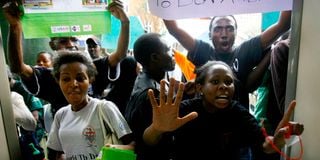Teaching sign language will be of benefit to all Kenyans

A Kenya National Association of the Deaf protest in 2013 to demand sign language interpreters on TV.
The Kenyan Sign Language (KSL) has been mentioned in various provisions in the Constitution. Recognised under the country’s national and official languages, the State is mandated to promote its development and use among other communication formats and technologies accessible to persons with disabilities.
Additionally, Kenya has ratified the Convention on the Rights of Persons with Disabilities and, as a state party, there are many obligations as far as ensuring that information intended for the general public reaches those who are deaf in a timely manner and without additional cost. But it is not always so.
I recently attended a public consultative forum whose primary target audience was the disability community, and, to the utter shock of many of us, there was no sign language interpreter. The meeting had to be postponed! The case continues to speak volumes as to how there is little effort to ensure KSL assumes the same level of recognition as English and Kiswahili, the two national spoken languages.
In a timely manner, and given that September is Deaf Awareness Month, it is useful to spotlight the Kenya Sign Language Bill 2023, which seeks to bridge the communication barriers between hearing and deaf people.
Among others, the Bill, co-sponsored by Nominated Senators Margaret Kamar (Jubilee) and Crystal Asige (ODM), seeks to have signing integrated into early childhood education generally and, in particular, KSL taught to all children in public and private early childhood education centres.
Tertiary education
Public institutions offering tertiary education shall do all that is reasonable and necessary to provide free interpretation services as may be needed by those who are deaf, hard of hearing or deafblind.
For many deaf people, those who are hard of hearing as well as the deafblind, such a bill spells a ray of hope, if only it can be the tool that is used to bridge barriers for their inclusion in the community.
But it should also excite hearing people because it is an attempt at bridging communication gaps and ensuring that deaf people are not excluded from any aspect of community life as is often the case. For example, in terms of attaining higher levels of education, many have had limited options not only in pursuing higher education but even the choices of what studies to take.
A young deaf leader known to me narrated the struggle she encountered to pursue a law degree in an institution that indicated it was not ready to accommodate a deaf person in class. Such a situation has also limited access to work opportunities for persons with hearing impairment.
The Bill is not just for the deaf community. An inclusive society is one in which both hearing and deaf persons collectively find ways to support everybody’s participation in the community.
It is also important to look at this Bill as one that not only benefits persons with hearing impairment or even other disabilities. Rather, it is an effort towards designing programmes and services, including the school curriculum, to be beneficial and usable by all people to the greatest extent possible without the need for adaptation or specialised design—the concept of Universal Design.
Ms Ombati is a disability rights advocate. [email protected].





